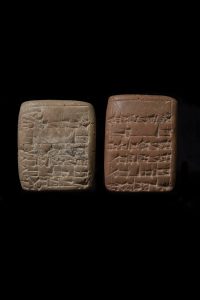Tags
Amnanum, Babylonian, cuneiform, dedication, inscription, King Sin-kashid of Uruk, Mesopotamia, nomads, Palace, Renee Kovacs, Sumer, Sumerian, Uruk, West Semitic Amorite

Rare Books thanks Dr. Renee Kovacs for the following translation of our clay tablets.
Palace Dedication Inscription of King Sin-kashid of Uruk
Old Babylonian period, c. 1900-1700 BC
Seven lines of Sumerian cuneiform, six on obverse, one on reverse.
The text of the inscription is known from 174 duplicates (identified in scholarly literature as Sin-kashid RIM E4.4.1.2). Some are written on small clay cones, others on clay or stone tablets. They were intended for foundation deposits, and were immured in the walls of the royal palace in great numbers. There are also many others expanded by a few lines of royal epithets.
Uruk was one of the most ancient cites of Sumer. The Amnanum were a tribe of West Semitic Amorite-speaking nomads who had come into southern Mesopotamia several centuries earlier.
An excellent reconstruction of the palace is shown at Artefacts: Scientific Illustration & Archeological Reconstruction.
Sin-kashid, mighty man, king of Uruk, king of Amnanum, built his royal palace (“a palace of his kingship”).
For detailed study of the palace and the related texts see the exhibition catalogue:
Fügert, A. and Sanati-Müller, S. 2013: Der altbabylonische Palast von Uruk und seine Texte, in: Crüsemann, N. et al. (editors), Uruk – 5000 Jahre Megacity. Ausstellungskatalog, Petersberg, 243-251.

You must be logged in to post a comment.